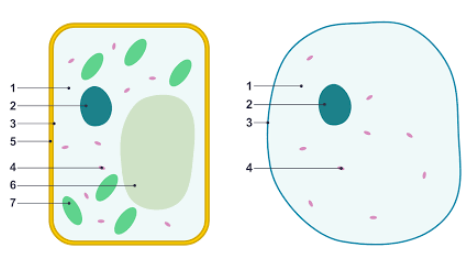
Label the parts of the diagrams given below.Identify which one is the plant cell and which one is animal cell.


Answer
498.6k+ views
Hint:As well as a cell membrane, plant cells have a cell wall. The cell wall of plants covers the cell membrane. This gives its distinctive rectangular form to the plant cell. The cells of animals simply have a cell membrane, but no wall of cells.
Complete answer:

Note:The fundamental unit of life is the cell. Many of life's events are done by cells. Organisms are defined on the basis of the number of cells in them. Unicellular species are single-celled, although there are a significant number of cells in multicellular organisms.
Complete answer:

| Animal cell | Plant cell | |
| Definition | Animal cells are also the basic functional unit of life for all cell organelles constituted by animals that perform a range of functions to support the metabolisms of animals. | Plant cells are essential plant functional units that make up all cell organelles that perform a range of functions that support the metabolisms of the plants. |
| Size and Shape | Animal cells are generally smaller with their cells varying in length from 10-30um than plant cells.The shape and sizes of animal cells, most defined by the role they play, vary greatly from irregular shapes to round shapes. | With the cell size varying from 10um-100um in length, plant cells are larger than animal cells.With most cells being rectangular or cube-shaped, plant cells are similar in type. |
| Cell wall | They lack a cell wall, but they have a plasma (cell) membrane that supports and protects the cell from external damage.It also plays a major role in the selective permeability of nutrient molecules, water, and other cell components, allowing in and outflow. | They both have a cell wall consisting of a cell membrane and cellulose. The cell wall is, on the surface of all plant cells, a rigid membrane matrix whose primary function is to protect the cell and its contents. |
| Cytoplasm | All the cell organelles are housed in it. | It hosts most of the organelles of the cell |
| Vacuoles | There may be several tiny vacuoles in animal cells, much smaller than plant cells. | Plant cells have a large central vacuole capable of occupying up to 90% of the volume of the cell. |
| Nucleus | Present, and it is located at the middle of the cell | Present, and it is located at the side of the cell |
| Plastids | Absent | They provide the plants with pigmentation colour and also promote the trapping of light energy used for photosynthesis. |
Note:The fundamental unit of life is the cell. Many of life's events are done by cells. Organisms are defined on the basis of the number of cells in them. Unicellular species are single-celled, although there are a significant number of cells in multicellular organisms.
Latest Vedantu courses for you
Grade 10 | CBSE | SCHOOL | English
Vedantu 10 CBSE Pro Course - (2025-26)
School Full course for CBSE students
₹37,300 per year
Recently Updated Pages
Master Class 11 Business Studies: Engaging Questions & Answers for Success

Master Class 11 Economics: Engaging Questions & Answers for Success

Master Class 11 Accountancy: Engaging Questions & Answers for Success

Master Class 11 Computer Science: Engaging Questions & Answers for Success

Master Class 11 English: Engaging Questions & Answers for Success

Master Class 11 Maths: Engaging Questions & Answers for Success

Trending doubts
The flightless birds Rhea Kiwi and Emu respectively class 11 biology CBSE

1 Quintal is equal to a 110 kg b 10 kg c 100kg d 1000 class 11 physics CBSE

A car travels 100 km at a speed of 60 kmh and returns class 11 physics CBSE

What is 1s 2s 2p 3s 3p class 11 chemistry CBSE

In tea plantations and hedge making gardeners trim class 11 biology CBSE

A difference between diffusion and osmosis is a A semipermeable class 11 chemistry CBSE




